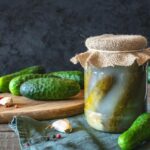Yeast can be both a cook’s helper and ruin a dish. What is yeast? They are single-celled fungi that multiply rapidly on contact with liquid and cause a fermentation process that makes the dough rise.
What types of yeast are there?
There are several varieties of yeast – each has its own characteristics.
- Pressed yeast is the most popular and bakers’ favorite type. They are also called live or fresh yeast. They make baked goods puffy and soft, and the dough rises quickly. Pressed yeast needs to be dissolved in water so that it begins to multiply. Pressed yeast is stored for about 12 days in a branded container, but only for a couple of days in an open container.
- Dry yeast is also called active yeast. It is often used in baking bread. They can be added to flour or other dry ingredients without being diluted in water. Dry yeast is stored much longer – up to 2 years in a closed container. But the dough with them is not as lush and flavorful.
- Quick-soluble yeast is a type of dry yeast with particularly fine granules. It’s convenient because you don’t have to make sourdough yeast beforehand. Simply knead this yeast directly into the dough and let it rise. Quick yeast makes the dough light, flavorful, and crusty.
- Beer and wine yeast are used to make beverages of the same name as well as kvass. They are not usually added to baked goods because of their specific flavor.
Regardless of the type of yeast you choose, be sure to check the expiration date before purchasing it. After the expiration date, yeast “dies” and has no effect on baking.
How to use yeast properly in baking
When making yeast dough, adhere to the following rules.
- Calculate the proportion of yeast. Usually, the amount of yeast to be added to the dough is given in the recipe. But if the recipe does not have such information – use about 30-50 g of yeast per 1 kg of flour. Also, remember that 10 g of dry yeast equals 30 g of pressed (live) yeast.
- Prepare the sourdough – to do this, add the yeast to the warm liquid (milk or water). This is where they will begin to multiply. The liquid must not be hotter than 35° C, or the yeast will die.
- Leave the sourdough for 15-20 minutes, then use it to make the dough.
- Do not add sugar to the sourdough immediately. This is a common culinary mistake. It is better to add sugar to the sourdough at the very end when the yeast has multiplied enough. Otherwise, the dough will not be as fluffy.
- Quick yeast is prepared without sourdough. They are added immediately to the dough.
Leave the yeast dough to rise for 20-50 minutes in a warm, but not hot place. You can put the dough near a radiator. Or heat the oven a little, turn it off, and put the pan with the dough in it. - Yeast dough should increase in volume twice. After that, you can mold and bake with it.
How else to use yeast in cooking besides baking
Yeast can thicken a soup or sauce – literally, a pinch of the product is enough. You can also add yeast to sour soups, rassolnik, and green borscht. For this purpose, yeast is first fried with onions and carrots and then added to the soup.



